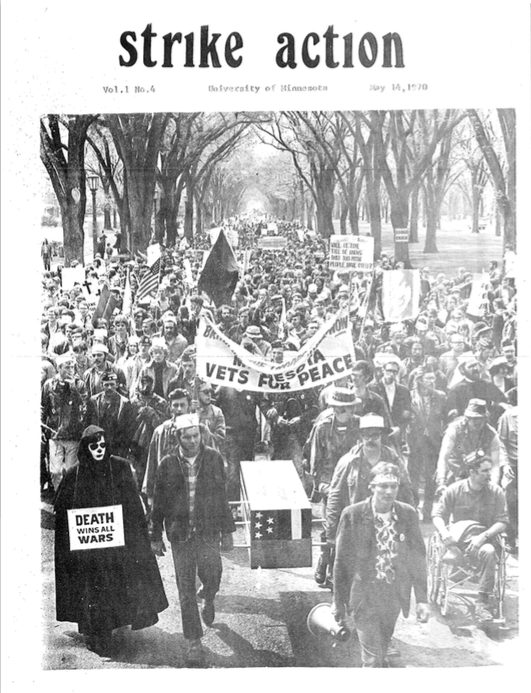
A cover of the strike movement newsletter, Strike Action, which illustrates the rally of demonstrators in May of 1970. Bill Tilton papers, University Archives, University of Minnesota, Twin Cities.
Throughout the spring of 1970, tensions were high amongst students and the campus community at the University of Minnesota in regards to the anti-war movement. At that time, President Richard M. Nixon decided to continue the United States’ military efforts, which ignited student strikes across the nation, including the University of Minnesota. Now fifty years later, we look back on the history of the student strike and the impact it had on campus and student activism.
Timeline of Events
Thursday, April 30, 1970
President Nixon announced his decision to enter military forces into Cambodia, which set off a wave of anti-war protests and strikes around the country.
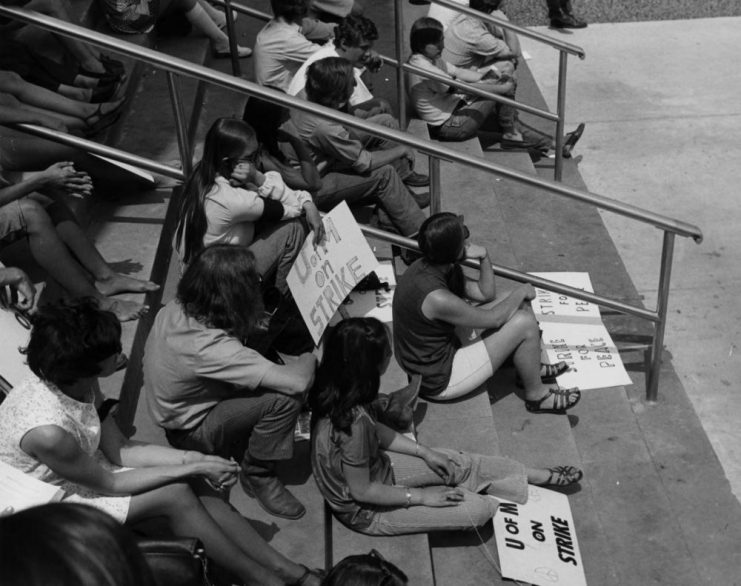
Students sit in groups, on strike for peace and protesting against the Vietnam war. Student protests. Strike. 1970. University of Minnesota Libraries, University Archives., umedia.lib.umn.edu/item/p16022coll175:4717 Accessed 27 May 2020.
Saturday, May 2, 1970
Students at Princeton University called for a nationwide student strike of colleges and universities. The Urban Research Corporation reported that 760 campuses were shut down in some capacity by students during the first week in May of 1970, of which the University of Minnesota was included (1).
Monday, May 4, 1970
On this day, four students were killed by the Army National Guard at Kent State University. A Strike Committee formed at the University of Minnesota, and a rally was held in front of Coffman Memorial Union with five thousand people in attendance. The Union, and later, the Campus Club, were occupied for use by strike activities. It was reported by Edwin O. Siggelkow, the Coffman Memorial Union Director, that the Union Board permitted the strike to make its headquarters there (1).
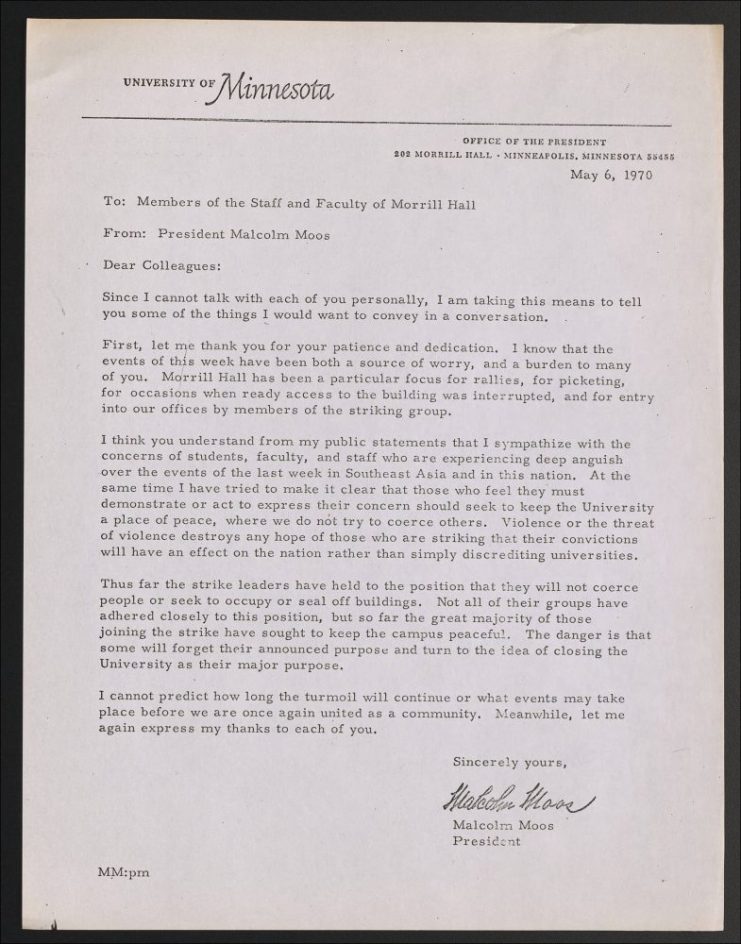
In this memo from President Malcolm Moos to the staff and faculty at Morrill Hall, he depicts his gratitude for their grace and patience. As Morrill Hall was known as a focus site for rallies and picketing, President Moos was hopeful that students would demonstrate peacefully. Alphabetical Files, Stud, 1966-1974. Student Strike. (Box 27, folder 11). 1970-03 – 1970-06. University of Minnesota Libraries, University Archives. umedia.lib.umn.edu/item/p16022coll372:2332 Accessed 28 May 2020.

The “Strike Call” flier announcing the student strike beginning and the demands of the strike. Bill Tilton papers, University Archives, University of Minnesota, Twin Cities.
Thursday, May 7, 1970
The Twin Cities Campus Assembly, the elected governing body of the Twin Cities campus of the University of Minnesota (3), provided resolutions on the Vietnam War and the student strike. These resolutions asked that all faculty seek to support students who were participating in the anti-war activities on campus and that they provide instruction in class and in alternative methods for students to continue their studies. The resolution also asked that the strike movement be conducted in a peaceful, non-violent manner and that a referendum on the resolution to be held across all constituencies (4). With the help of the Student Senate, the Twin Cities Campus Assembly provided organized channels for voicing concerns and frustrations to the University system (5).
President Moos travels to Washington with seven other university presidents to consult with President Nixon about events on the nation’s campuses and the concerns of the students (7).
Friday, May 8, 1970
The University administration recognizes this day as a day of reflection on the events in Southeast Asia and recommends the same for other campuses (7).

A view from the State Capitol during a rally from the student strike in May 1970. Bill Tilton papers, University Archives, University of Minnesota, Twin Cities.
Saturday, May 9, 1970
A group of students, faculty, and community members marched to the Minnesota State Capitol. The rally participants were estimated between twenty to fifty thousand.

A cover of the strike movement newsletter, “Strike Action,” dated May 12, 1970. Bill Tilton papers, University Archives, University of Minnesota, Twin Cities.
Wednesday, May 13, 1970
The Union Board of Governors met to vote on discontinuing further support of the strike effort but failed by a vote of 6 to 4. A motion to extend an additional 500 dollars for operations of facilities and services was approved by a vote of 9 to 1 (1).
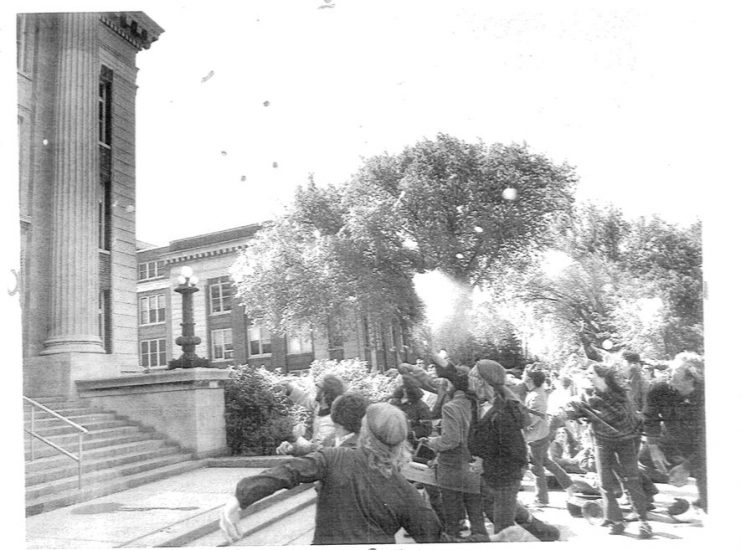
Students gather at Morrill Hall during the student strike tossing items at the building. Bill Tilton papers, University Archives, University of Minnesota, Twin Cities.
Friday, May 15, 1970
Just after midnight, two students are killed and a dozen injured after police open fire at a rally at Jackson State College in Mississippi.
Tuesday, May 26, 1970
Protesters participated in an anti-ROTC rally in front of Morrill Hall. Fifteen strikers blocked entrances into the building during this demonstration (2). Stated in the article, “Moos, U attorney to testify in Morrill disruption case,” by M. Howard Gelfand in the Minnesota Daily, it was said that “Members of the group were boisterous and making much noise by shouting, blowing whistles and kazoos, banging on a 55-gallon oil drum and throwing water-filled balloons against the building and at persons entering and exiting the building…” (2).
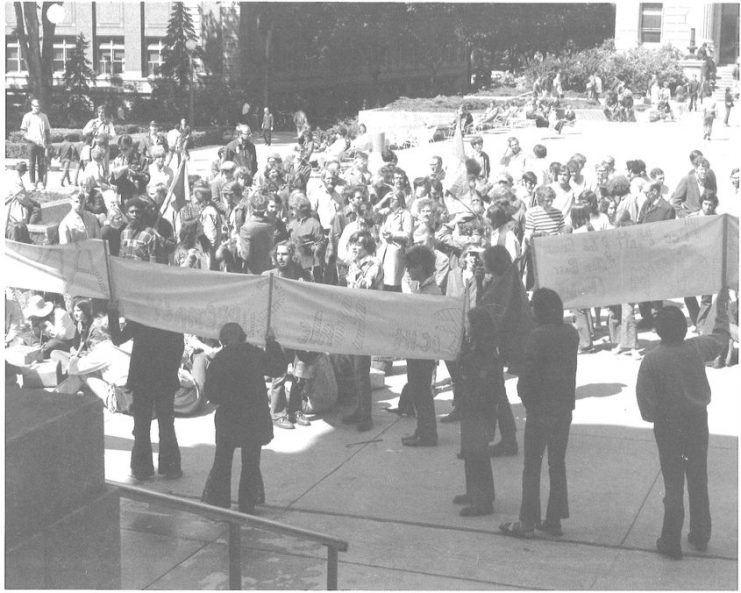
Students participate in an anti-war rally on campus. Bill Tilton papers, University Archives, University of Minnesota, Twin Cities.
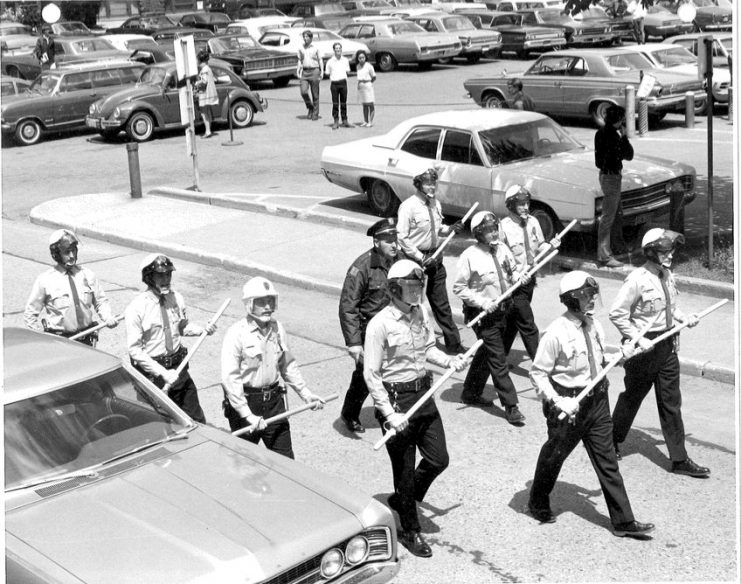
Police enter the anti-ROTC rally at Morrill Hall on May 26th, 1970. Bill Tilton papers, University Archives, University of Minnesota, Twin Cities.
Wednesday, May 27, 1970
The Union Board received a memo from Vice President Cashman and Assistant Vice President Donald Zander that they wanted the Union to close for Memorial Day weekend. The student-organized Peace College offered a plan to have a three day reflection period for strike participants to contemplate on their past efforts, develop plans for redirection, and to scale-back the demands upon the Union (2). They were worried that closing the building would produce violent reactions.
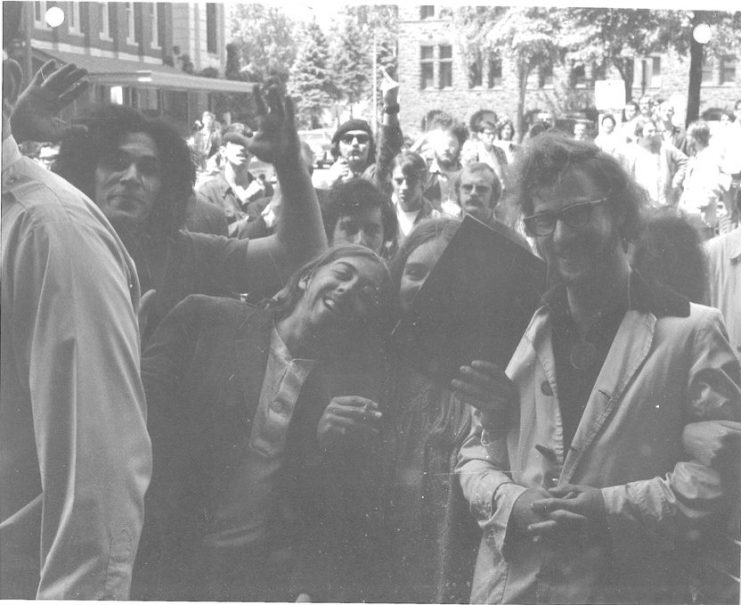
Students linking arms during a rally in May of 1970. Bill Tilton papers, University Archives, University of Minnesota, Twin Cities.
Monday, June 1, 1970
The Union Director canceled all food-related privileges when a cooler and vending machine were broken. This then sparked a meeting where the food service people expressed the desire to cease overnight occupancy of strikers, including access to all kitchen area and locker rooms. Custodians also complained about the cleanup and the occupancy after normal closing hours (2).
Wednesday, June 3, 1970
The Union Director prepared a negotiation that would terminate the strike occupancy of Coffman Union on June 5th, rather than the established June 12th date.
Friday, June 5, 1970
Vice President Cashman, Assistant Vice Presidents, Zanders and Reeves, and the President’s Assistant, Miss Eileen McAvoy secured the Union at 11:00 pm. When the remaining strikers resisted leaving the premises, police were called and escorted them out.

A scene from the Morrill Hill blockade during the student strike in May of 1970. Bill Tilton papers, University Archives, University of Minnesota, Twin Cities.
Saturday, June 6, 1970
Strike leadership and faculty members gathered to discuss the termination of the strike. At 1:30 pm, strike personnel withdrew to deliberate their “housing problem” and determined the effectiveness of their activities were not dependent upon the 24 hour a day occupancy of the building (2).
Educational Impact
The overall result of the student strike had an educational impact on campus. Some professionals found the strike to have “energized teaching and learning” while others suggest that it “diverted and scattered the interest and energies of students and faculty and thus impeded teaching and learning” (2). About one-third of the students who participated in the student strike missed 50 percent or more of their classes. However, many public forums, teach-ins, independent studies, and community action efforts began as a result of the student strike (2). A new for-credit course, “A Crisis in America,” enrolled 700 students and had 50 faculty teaching seminar sessions (2).
Among these teach-in and independent studies, an alternative educational opportunity was offered. The Peace College, a part of the University of Life, stemmed from the strike events and organizers (8) and allowed students, staff, and non-university affiliated citizens to participate. The Peace College encouraged individual pursuits and highlighted activism and cultural issues.

“Peace College” flier. Bill Tilton papers, University Archives, University of Minnesota, Twin Cities.
Outside of academic education, the events of the student strike also resulted in the broadening of knowledge, both culturally and organizationally. In his report, “Coffman Memorial Union and the Cambodian Protest Strike, Spring 1970,” Siggelkow stated that “many students were motivated to more deeply study and consider the background of the Vietnam conflict and to confront more of the complexities; many students gained new insights into organizational needs and rediscovered some of the conventional necessities of organization, planning and control” (2).
However, there was one anti-strike group, dubbed the “Minnesota Majority,” that strove to make sure that the University remained open for classes during the student strike. With neither a pro nor con view on the war in Vietnam, the “Minnesota Majority” had the objective of seeing that the students receive the education they paid for (2). It was illustrated in a news release, entitled, “‘Minnesota Majority’ Forms to Keep ‘U’ Open,” that the group suggested a tuition refund for classes not held during the ‘days of reflection’ and for days that their striking instructors were not in class (2).
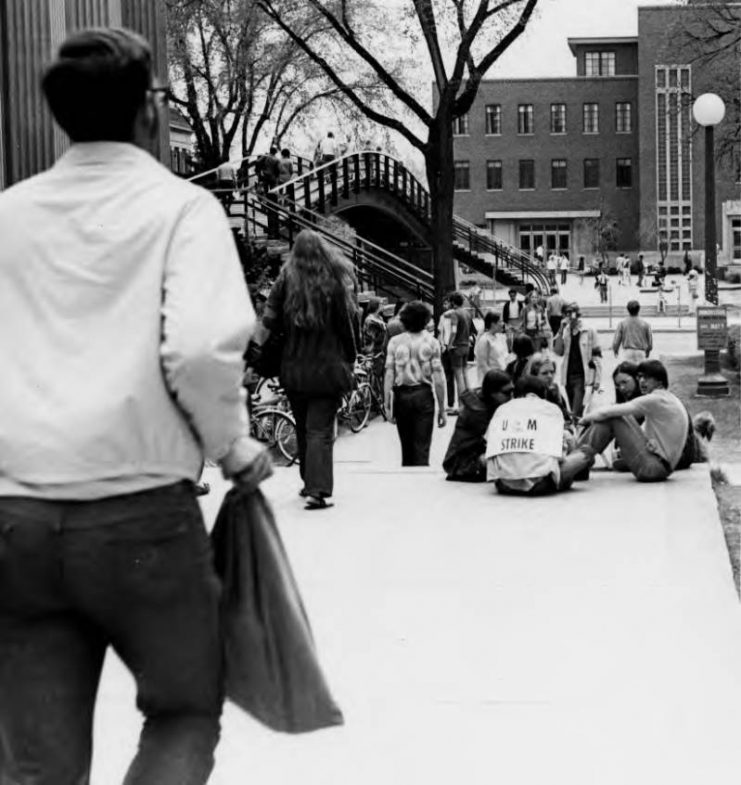
Campus life illustrated through students in protest in the Spring of 1970. Student Protest. 1970. University of Minnesota Libraries, University Archives., umedia.lib.umn.edu/item/p16022coll175:3866 Accessed 27 May 2020.
Students Perspective
One of the most pivotal moments of the student strike was the anti-ROTC demonstration at Morrill Hall on May 26th, 1970. Among the students involved, fifteen were arrested and charged with unlawful assembly. At their trial, many of those charged represented themselves. Included in this was George Grosshandler, who testified that he and his wife, Virginia, linked arms with other demonstrators in front of Morrill Hall in an attempt to stop people from entering the building (2). He defended himself and the others by stating that the linking of the arms was only symbolic (2). He also told the jury that he expected to be arrested because “when people stand up or attempt to get people to stand up against institutions like ROTC, they are crushed” (2).
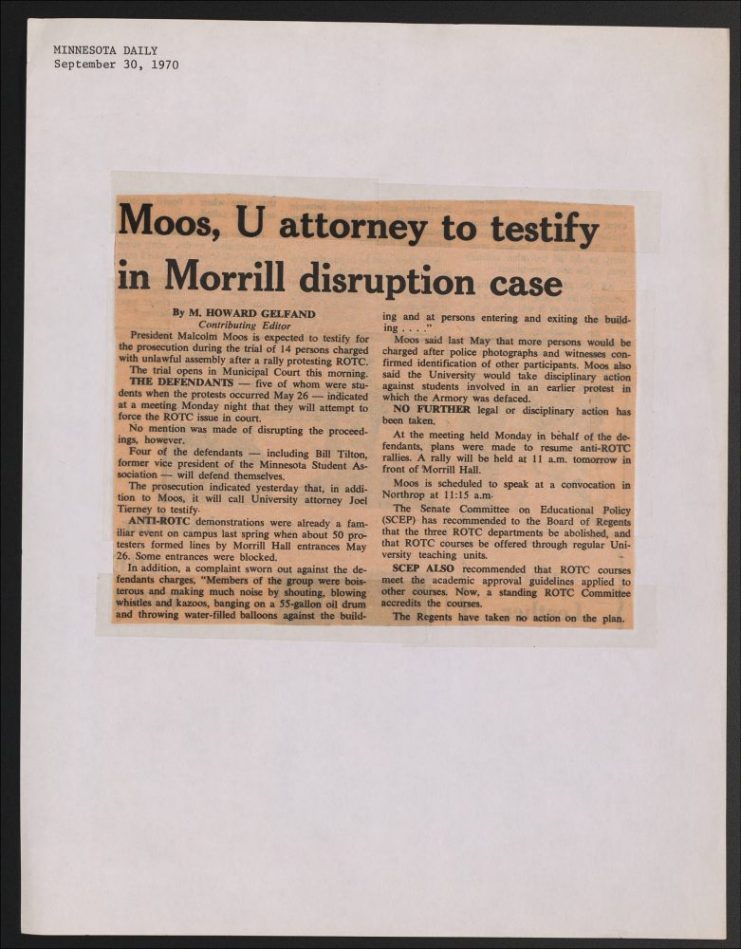
An article found in the Minnesota Daily, written by M. Howard Gelfand, retelling the details from the student strike protest that happened on May 26th, 1970 in front of Morrill Hall. Strikers picketed the building as to not allow anyone inside. Alphabetical Files, Stud, 1966-1974. Student Strike. (Box 27, folder 12). 1970-03 – 1970-06. University of Minnesota Libraries, University Archives. umedia.lib.umn.edu/item/p16022coll372:4202 Accessed 28 May 2020.
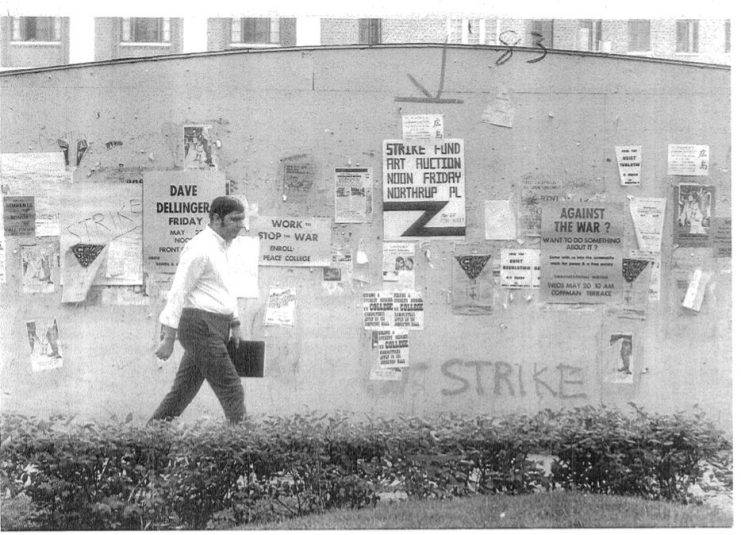
A man walks past posters and fliers anti-war messages and support for the student strike on campus. Bill Tilton papers, University Archives, University of Minnesota, Twin Cities.
Bill Tilton, the Vice President of the Minnesota Student Association, also represented himself in court and emerged as one of the main leaders amongst the student strike. During the trial, Tilton questioned President Moos with the verse, “it isn’t nice to block the doorway/It isn’t nice to go to jail/There are nicer ways to do it/But the nice ways always fail” (2).
Tilton continued to work in opposition to the Vietnam War when he among seven peers attempted to destroy draft records in three Minnesota towns, including Little Falls, Alexandria, and Winona on July 10, 1970. Known as the Minnesota 8, the men were arrested and held on a $50,000 bail with charges of attempted sabotage, which were later reduced to attempted burglary. Along with Tilton, the other seven members of the group included Cliff Ulen, Chuck Terchick, Mike Therriault, Brad Beneke, Don Olson, and Pete Simmons. Ulen received probation, while the other seven were convicted and sentenced to five years in federal prison, in which they served up to twenty months.
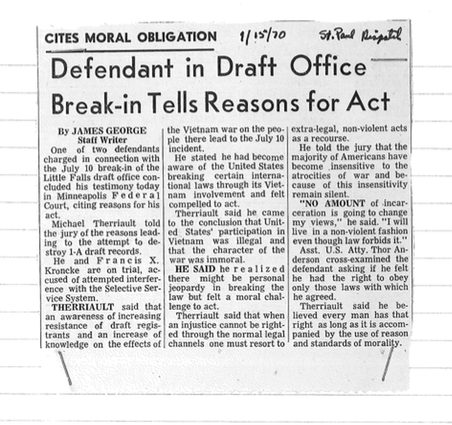
A misdated news article from the St. Paul Dispatch on the trial of two members of the Minnesota 8. The trial took place in January 1971. Bill Tilton papers, University Archives, University of Minnesota, Twin Cities.
New Collections
Two recently acquired collections provide further content and context for the events of the spring and summer of 1970. Bill Tilton donated his personal papers to the University of Minnesota Archives. Tilton’s materials include personal writings, notes related to his legal cases, and publications, both local and national, documenting student activism on and off-campus, the student strike, and other demonstrations during that time. It also contains materials Tilton collected while working for the defense during the Wounded Knee trial and while serving on the Minnesota Prison Investigation panel.
The second collection is a set of oral histories and papers compiled by Peter Simmons, one of the members of the Minnesota 8, with the assistance of the Minnesota Independent Scholars Forum. The interviews include conversations with those who carried out raids against Selective Service offices, including the Minnesota 8, as well as others, and those who actively resisted the draft through acts of civil disobedience. Their stories document their individual choices while providing an extensive understanding of activism through protests and demonstrations.
Sources
(1) University of Minnesota. President’s Office. Protests and Disputes. Demonstrations (Morrill Hall Takeover). (Box 175, Folder 2). 1970 – 1973. University of Minnesota Libraries, University Archives. https://umedia.lib.umn.edu/item/p16022coll374:7461 Accessed 27 May 2020.
(2) Alphabetical Files, Stud, 1966-1974. Student Strike. (Box 27, folder 12). 1970-03 – 1970-06. University of Minnesota Libraries, University Archives. https://umedia.lib.umn.edu/item/p16022coll372:4202 Accessed 28 May 2020.
(3) Twin Cities Campus Assembly Bylaws, superseded July 2005.
(4) Alphabetical Files, Stud, 1966-1974. Student Strike. (Box 27, folder 10). 1970-05. University of Minnesota Libraries, University Archives. https://umedia.lib.umn.edu/item/p16022coll372:90 Accessed 28 May 2020.
(5) Alphabetical Files, Ca-Col, 1964-1974. Campus Demonstrations. Reports on Issues (B. A. March). (Box 5, Folder 9). 1974. University of Minnesota Libraries, University Archives. https://umedia.lib.umn.edu/item/p16022coll372:2253 Accessed 28 May 2020.
(6) Bill Tilton papers, University Archives, University of Minnesota, Twin Cities. https://archives.lib.umn.edu/repositories/14/resources/9252.
(7) University of Minnesota. (1970). Fact Sheet on University of Minnesota Activities During the Nationwide Student Strike. University of Minnesota. Retrieved from the University of Minnesota Digital Conservancy. http://hdl.handle.net/11299/122367.
—Katelyn Morken is a project archivist for the University of Minnesota Archives. To learn more about the University of Minnesota Archives, please visit www.lib.umn.edu/uarchives.





The founders were well aware of the volatile nature of the immigrants to the U.S. which included an unusual proportion of risktakers, misfits, rebels, and also (as Drs Hallowell and Ratey pointed out in their classic book: Driven to Distraction), persons with attention deficit disorder. These are often highly creative people but with not necessarily stable styles. The founders were deeply concerned about emotionally-driven movements by people absolutely convinced they were right and so ready to run over the views of those who disagreed with them. That’s why they chose divided authority – checks and balance system.
The list of demands by students to the Administration, Faculty and Faculty Senate are classic examples. Student leaders at the Harvard strike and takeover of buildings in 1968 addressed thousands of students in the football stadium with bullhorns, asserting that the faculty should learn from the students because their ideas were old and outdated, whereas the students had new, creative ideas. Longshoreman philosopher Eric Hoffer had some thoughts about this. He said “A book of the wisdoms of 20 year olds would be a collection of asinine pronouncements”. My father, a sociology professor, responded to the widespread slogan, “Never trust anybody over 30”, by his own principle “I never trust anybody under 60!”.
Terrific summary; thank-you Ms. Morken.
In case this part of UofMN history might have been lost: The students in former Vice-President Hubert Humphrey’s class voted to continue that particular class during the spring of 1970. We never missed a class, enjoying his story-telling that went over-time most sessions. Then, some of us, at least, went back to the protests.
(I am a graduate of the Experimental College that began in the autumn of 1970, which might of had its roots in the Peace College.)